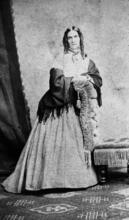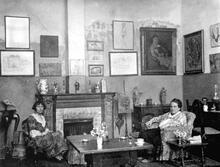Rachel Mordecai Lazarus
Rachel Mordecai Lazarus began her career as the head instructor of her father’s girls’ boarding school. In 1815 she wrote a thoughtful letter to her favorite author, Maria Edgeworth, questioning why her latest novel used a stereotypical Jew as a stock villain; this correspondence sparked a lifelong friendship. After marrying in 1821, Lazarus began studying Judaism to better educate her stepchildren, but she found the prayers numbing and synagogue culture uninspiring. After Christian evangelical friends nursed her through a near–fatal childbirth experience in 1828, her faith was further shaken. In 1835 she announced her intention to convert, causing her husband to threaten that he would take their children away. She continued as a Jew but became an Episcopalian on her deathbed.
Friendship with Maria Edgeworth
In 1815, Rachel Mordecai Lazarus, a twenty-six-year-old North Carolina schoolteacher, met a “Shylock.” Dishearteningly, he was a character in her favorite writer’s latest novel. Even worse, the malicious London coachmaker of Maria Edgeworth’s The Absentee (1812) was named Mr. Mordicai. The sting festered, and Rachel wrote to Edgeworth, a best-selling Irish writer of fiction and progressive educational guides, requesting an explanation.
Lazarus’s genteel, principled criticism moved and shamed Edgeworth, who not only begged pardon but set out in her next tale to unveil antisemitism’s irrational roots. So began an epistolary friendship that continued until Rachel Mordecai Lazarus’s death, though few knew of it. Adhering closely to social strictures on women—to be widely known was to risk one’s virtue—she refused ever to have her name publicly linked to Edgeworth or to the apologetic novel she inspired, Harrington (1817).
Early Life
The eldest girl in a family of thirteen, Rachel Mordecai Lazarus was born July 1, 1788, in Goochland County, Virginia. Both her parents had Ashkenazic roots. Her father, Jacob, grew up in Philadelphia. Her mother, Judith, was the eldest daughter of colonial New York silversmith Myer Myers. When Rachel was three, the family moved to Warrenton, North Carolina, where they were the small town’s sole Jews.
Following her mother’s death, her father married his sister-in-law Rebecca Mears Myers. When the family store failed, the Mordecais opened a girls’ boarding school in 1809, with Rachel Lazarus as head instructor. The academy quickly filled up with daughters of the region’s Protestant plantation elite, who were joined by a handful of girls from southern Jewish families.
Marriage and Religion
In 1821, Rachel married the widower Aaron Lazarus, a Wilmington, North Carolina, merchant, and shipper. After years of teaching strangers, Lazarus saw her new domestic circle as the proving ground for her conviction—based on Enlightenment and early feminist ideas, alongside a strenuous domesticity—that the family itself was the institution where affection and intellectual life, through continual instruction, could best flourish.
Religion did not play a large part in this vision, but when Aaron Lazarus’s son Gershon nearly converted in 1823, Rachel Lazarus immersed herself in Judaism in order to better understand—and defend—her faith. But she found in the prayers “so much repetition, so many epithets strung together, that the mind cannot fix itself on the sense of each in repeating them, and this in a measure prevents devotion.” Five years later, an almost fatal infection contracted in childbirth gave greater urgency to Lazarus’s religious search. The baby was named Mary Catherine, after Lazarus’s closest female friends, evangelical Christians who nursed her through her darkest hours.
Successive pregnancies frightened and disappointed Lazarus. Each new child required years of education, which was work Lazarus felt she must manage closely. Her husband was preoccupied with business. Most upsettingly, continued religious studies only deepened Rachel’s attraction to Christianity. Her dream of enlightened domesticity was flickering out. An emotional and physical breakdown convinced Lazarus, in 1835, to go where faith led her. She announced her intention to convert, setting off a bitter struggle with her father and husband.
Aaron Lazarus threatened to take their children (Marx Edgeworth, Ellen, Mary Catherine, and Julia) away if she left the faith. Lazarus relented, but for the remaining years of her life believed as a Christian in all but name. On her deathbed, at the home of her still-Jewish siblings Samuel Mordecai and Ellen Mordecai in Petersburg, Virginia, Lazarus was baptized into the Episcopal Church.
Legacy
With almost no formal education, Lazarus defied the view of women as intellectually inferior to men and systematically pursued a life of the mind within the private sphere. Though she grew up far from an organized Jewish community, for most of her life she defended the faith of her fathers as vigorously as any American Jewish woman of the time. Lazarus and her siblings, professionals who always mixed freely with gentiles, regularly faced questions about their belief and strained to fit Judaism to their lives. Only two of Mordecai’s thirteen children became practicing Jewish adults.
Despite an almost excessively dutiful nature, Lazarus balked at the patriarchal Judaism practiced by her father and husband and called for changes that Reform Judaism brought only after her death. First as an intellectual, later as a Christian, and always as a dutiful woman, Rachel Mordecai Lazarus sought meaning in ideals. Not surprisingly, the world and the people she loved never lived up to her dreams.
Rachel Mordecai Lazarus died on June 23, 1838.
Berman, Myron. Richmond’s Jewry, 1769–1976: Shabbat in Shockoe (1979).
Bingham, Emily S. “‘Mind Torn ... Spirit Broken’: Enlightened Domesticity and Evangelical Piety in the World of Rachel Mordecai Lazarus.” Master’s thesis, University of North Carolina, 1991.
Craft-Fairchild, Catherine. "The “Jewish Question” on Both Sides of the Atlantic: Harrington and the Correspondence between Maria Edgeworth and Rachel Mordecai Lazarus." Eighteenth-Century Life 38, no. 3 (2014): 30-63.
MacDonald, Edgar E., ed. The Education of the Heart: The Correspondence of Rachel Mordecai Lazarus and Maria Edgeworth (1977).
Mordecai, Alfred. Papers. Library of Congress, Washington, D.C.
Mordecai, Jacob. Papers. Special Collections Library, Duke University, Durham, N.C.
Mordecai Family Papers. Southern Historical Collection, University of North Carolina, Chapel Hill.
Myers Family Papers. Virginia Historical Society, Richmond, VA.
Richards, Penny Leigh. “‘A Thousand Images, Painfully Pleasing’: Complicating Histories of the Mordecai School, Warrenton, North Carolina, 1809–1818.” Ph.D. diss., University of North Carolina, 1995.
Sarna, Jonathan D. “The American Jewish Response to Nineteenth-Century Christian Missions.” Journal of American History 68 (June 1981): 35–51.
Todd, Emily B. "Ways of Wisdom: Moral Education in the Early National Period, Including the Diary of Rachel Mordecai Lazarus." The Virginia Magazine of History and Biography 109, no. 3 (2001): 332.




